Psoriasis is a pink rash with silvery scales. It causes itching and occurs in millions of people around the world. If a person or his relatives do not have such rashes, it does not mean that they will not appear. It is important to start treating the disease at an early stage of psoriasis and not start it on a severe scale.
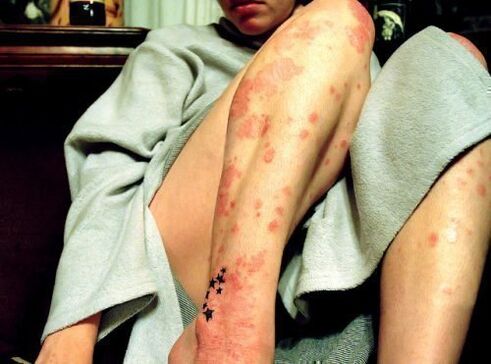
Psoriasis can be inherited, but not in all cases.
Characteristics of the disease
Psoriasis is not an infection and the cause of its occurrence is considered to be a violation of the functions of the immune system. And also the disease can be the result of external factors, skin damage, stress, alcohol, antibiotics, infections.
Wounds can cover any part of the body. Rash is especially common on the hands and feet. They also occur on the palms, soles, scalp and nails.
Psoriasis is a chronic disease that has a wavy flow. The person may experience periods of reduced redness or cause a worsening. Recurrences can be caused by various external factors.
Psoriasis does not affect normal life and does not require constant hospitalization. Despite this, it is a serious pathology that brings many concerns and limitations.
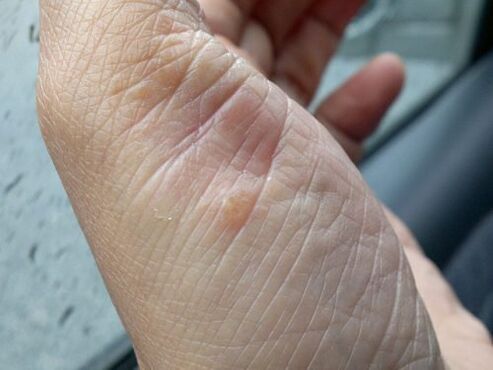
Manifestations of psoriasis can fade and become almost invisible.
Conditional segregation of psoriasis
There are several forms of psoriasis:
- vulgar;
- seborrheic;
- in the form of dots;
- palmar-foot;
- psoriasis in the genitals.
The most common psoriasis is the vulgar form of the disease. With it, there are edematous rashes of a bright color, which are accompanied by severe itching.
There are three degrees of psoriasis, depending on the size of the affected area:
- Light weight. About 3 percent of the skin is affected.
- Medium The number of rashes varies from 3 to 10 percent of the skin surface.
- Severe redness occupies 10 or more percent of the skin surface.
Sometimes the disease invades the joints. This is the most severe degree, no matter what percentage of the skin is affected by plaque. It can lead to the development of psoriatic arthritis, which is accompanied by pain and swelling in the articular parts of the bones.
There are three stages of psoriasis according to the degree of deterioration:
- progressive;
- stationary;
- regressive
Even a doctor may not always be able to recognize psoriasis at a particular stage. In many cases, special monitoring of disease development is required. This will help determine if psoriasis is progressing to remission or not.
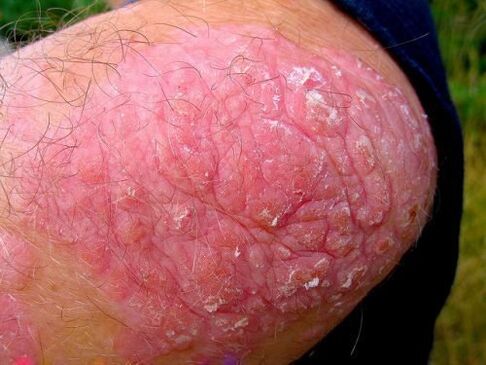
Psoriasis vulgaris has a bright pink color.
Progressive phase
In the initial stage, psoriasis develops quite quickly. Various rashes appear on the arms, back, buttocks and legs, which grow over time and form plaques. The progression of the disease is characterized by severe itching of the affected areas, which become moist and can cause infection.
Early psoriasis is curable. Therefore, it is important to establish the correct diagnosis in time. At the first symptoms of psoriasis in the initial stage, you should consult a doctor. Only he can determine the nature of the skin disease and the stage of its development.
You can independently understand what psoriasis looks like from several signs:
- Rash appears in places where the dressing is in close contact with the body. For example, on the arms in the elbow area, under the belt of the pants, elastic bands.
- The itchy rash is covered with gray scales.
- If you remove the scale, you can see thin and damp skin down.
- The condition of the nails is disturbed, pits appear in them.
Do not use any oil without consulting your doctor. The use of some remedies at an early stage of the disease can lead to the formation of stretch marks, thinning of the epidermis and addiction.
Usually, your doctor will prescribe a non-hormonal zinc-based medication. This is an effective remedy that allows you to relieve itching, reduce the proliferation of skin cells and inflammation, restore the skin’s protective functions and reduce the development of psoriasis to a progressive stage.
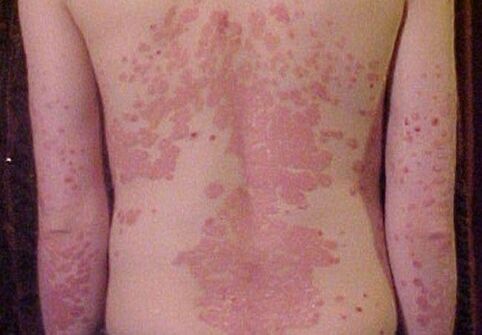
Psoriasis occurs mainly in places where the skin and clothing come in contact.
Stationary phase
The previous stage is replaced by the stationary stage of psoriasis. Inflamed joints do not disappear, but do not grow. The plaques become dry and the inflammation is reduced.
For the treatment of the stationary phase of psoriasis, preparations containing tar are very often used. Sometimes systemic therapy is used and the body is affected by ultraviolet radiation.
Regressive phase
This is the final stage of psoriasis, in which the plaques begin to shrink and slowly disappear. Resorption occurs from the middle of the wound and by the end of this stage, small rings and patterns remain on the skin. The itching and skin disappear. After a rash, the barely visible pigmented areas remain on the skin.
This process is the end of the psoriasis cycle, but it is not a complete recovery. The disease can recur at any time. If left untreated, plaques will appear regularly.
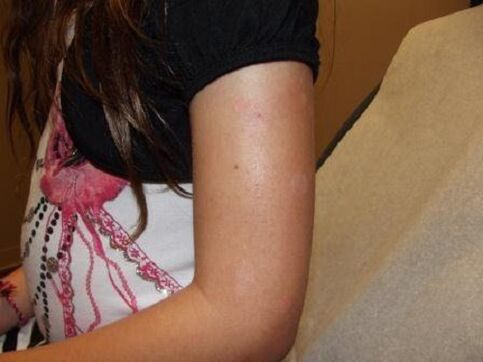
After psoriasis, spots and patterns may remain on the skin.
Treatment and prevention of psoriasis
Every person should monitor their health and pay extra attention to the skin:
- Avoid washcloths that can scratch your skin.
- It is preferable to use special medical shampoos. This is especially true for scalp psoriasis.
- It is necessary to take care of the optimal humidity of the indoor air in order to avoid drying of the skin.
- Avoid scratches, injuries and cuts on the skin.
- A certain diet that improves the course of the disease should be followed.
- One of the main rules of prevention is the refusal of alcohol. You should not drink alcohol and quit smoking.
- Wear loose clothing that will not cause cuts.
For the prevention and treatment of psoriasis, a special massage is used. Improves blood circulation so that the skin is cleansed faster. The areas of the body around the plates extend a few centimeters and turn backwards. The procedure takes about 15 minutes.
The symptoms of the disease occur against the background of psychoemotional stress. Therefore, it is important to keep stress to a minimum. They recommend practicing different methods of relaxation, adequate sleep and greater rest, use of herbal preparations and sedatives.
Some patients use folk remedies at home. To do this, use various herbal infusions and decoctions, egg and fat oils, garlic compresses and bedtime lotions. Alternative methods should be used after consulting a specialist.
Some medications can cause relapse and side effects. They should only be taken as directed by your healthcare professional. Unfortunately, there is no single remedy that can get rid of psoriasis 100 percent forever. You can keep the disease in remission only by choosing the right medicines.























